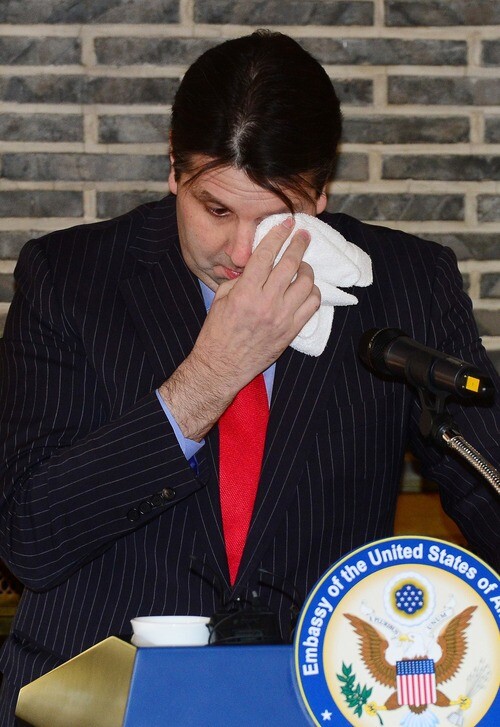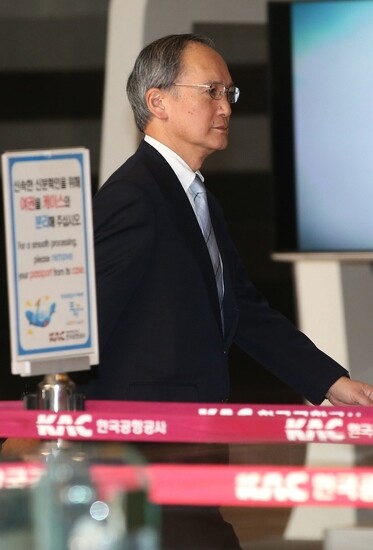hankyoreh
Links to other country sites 다른 나라 사이트 링크
Relations with US and Japan stalled with no ambassadors for over two months

South Korea hasn’t had ambassadors from the US and Japan for well over two months now, and this situation is almost sure to continue for some time.
The position of US ambassador to South Korea has been vacant since Donald Trump took office on Jan. 20. As of Mar. 26, this vacancy has lasted for 65 days, since the former ambassador, Mark Lippert, returned to the US. But not only has no one been nominated to replace Lippert, there’s not even any speculation about who the eventual nominee might be. For more than two months, the US Embassy to South Korea has been supervised by Charg? d‘Affaires ad interim Marc Knapper.
Iowa Governor Terry Branstad was nominated to be the US ambassador to China in Dec. 2016, even before president-elect Trump had been inaugurated. And then on Mar. 24, Trump nominated William Hagerty, a former businessman in the finance sector, to be the US ambassador to Japan. Aside from South Korea, Trump has filled all the major diplomatic posts in Northeast Asia.
At a time when North Korea has pledged to test launch an ICBM and when some think it could carry out a nuclear test, there are concerns that this vacancy might well affect cooperation between South Korea and the US.
But foreign policy officials do not seem very worried. There is precedent for vacancies in the post of US ambassador to South Korea - eight months in 1993, during the transfer of power from George H. Bush to Bill Clinton, and six months in 2001, during the transfer of power from Clinton to George W. Bush. “There aren’t any particular difficulties because Washington is handling the important matters directly,” said one official from South Korea’s Ministry of Foreign Affairs.

The absence of the Japanese ambassador to South Korea is also continuing. On Jan. 9, Japan recalled ambassador Yasumasa Nagamine to protest the setting up of a comfort woman statue in front of the Japanese Consulate to Busan at the end of 2016. Hideo Suzuki, minister and deputy chief of mission at the embassy, is serving as the acting ambassador. Though 76 days have passed, South Korea’s relations with Japan remain at an impasse over the comfort woman agreement reached on Dec. 28, 2015, and the comfort woman statue in Busan. Some analysts suggest that Japanese Prime Minister Shinzo Abe, the key decision maker in this situation, has been too preoccupied recently over allegations about a preferential land grant to a school to decide to send the ambassador back to South Korea.
South Korea will probably have to go without ambassadors from the two countries for the time being. Reports suggest that the American ambassador is likely to be appointed after South Korea‘s presidential election on May 9.
“It’s only natural that the US would want to appoint its ambassador after seeing how the next administration will take shape,” said one source involved with foreign policy.
“Japan missed the timing to return its ambassador back. It seems to have wasted a good opportunity,” said a source from South Korea’s Ministry of Foreign Affairs.
By Kim Ji-eun, staff reporter
Please direct questions or comments to [english@hani.co.kr]

Editorial・opinion
![[Column] Season 2 of special prosecutor probe may be coming to Korea soon [Column] Season 2 of special prosecutor probe may be coming to Korea soon](https://flexible.img.hani.co.kr/flexible/normal/500/300/imgdb/original/2024/0426/3317141030699447.jpg) [Column] Season 2 of special prosecutor probe may be coming to Korea soon
[Column] Season 2 of special prosecutor probe may be coming to Korea soon![[Column] Park Geun-hye déjà vu in Yoon Suk-yeol [Column] Park Geun-hye déjà vu in Yoon Suk-yeol](https://flexible.img.hani.co.kr/flexible/normal/500/300/imgdb/original/2024/0424/651713945113788.jpg) [Column] Park Geun-hye déjà vu in Yoon Suk-yeol
[Column] Park Geun-hye déjà vu in Yoon Suk-yeol- [Editorial] New weight of N. Korea’s nuclear threats makes dialogue all the more urgent
- [Guest essay] The real reason Korea’s new right wants to dub Rhee a founding father
- [Column] ‘Choson’: Is it time we start referring to N. Korea in its own terms?
- [Editorial] Japan’s rewriting of history with Korea has gone too far
- [Column] The president’s questionable capacity for dialogue
- [Column] Are chaebol firms just pizza pies for families to divvy up as they please?
- [Column] Has Korea, too, crossed the Rubicon on China?
- [Correspondent’s column] In Japan’s alliance with US, echoes of its past alliances with UK
Most viewed articles
- 1‘We must say no’: Seoul defense chief on Korean, USFK involvement in hypothetical Taiwan crisis
- 2[Column] Season 2 of special prosecutor probe may be coming to Korea soon
- 3N. Korean delegation’s trip to Iran shows how Pyongyang is leveraging ties with Moscow
- 4Korea sees more deaths than births for 52nd consecutive month in February
- 5Amnesty notes ‘erosion’ of freedom of expression in Korea in annual human rights report
- 6[Reportage] On US campuses, student risk arrest as they call for divestment from Israel
- 7[Editorial] New weight of N. Korea’s nuclear threats makes dialogue all the more urgent
- 8‘Weddingflation’ breaks the bank for Korean couples-to-be
- 9[Column] Has Korea, too, crossed the Rubicon on China?
- 10[Column] Park Geun-hye déjà vu in Yoon Suk-yeol